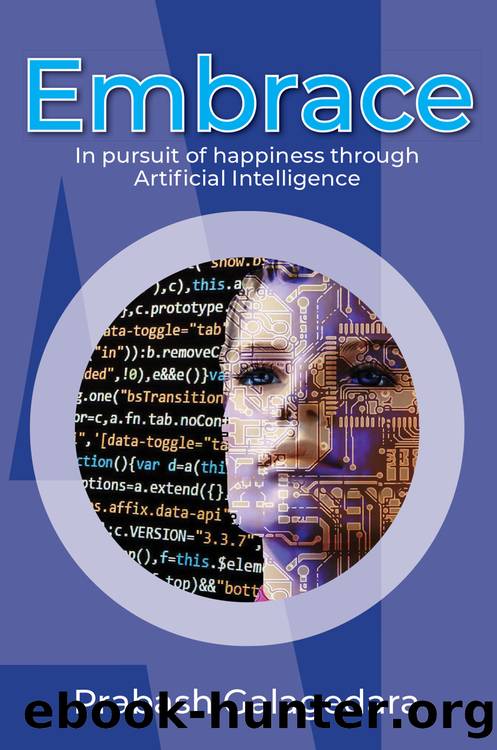Embrace by Prabash Galagedara

Author:Prabash Galagedara
Language: eng
Format: epub
Publisher: Busybird Publishing
2 - CSIRO, 12 September 2017, âAI technology to help prevent blindnessâ, news release, viewed May 2022, https://www.csiro.au/en/news/news-releases/2017/ai-technology-to-help-prevent-blindness
Dr Joseph J. Atick, the father of commercial facial recognition, explained the discovery to the MIT Tech Review.3
Dr Joseph J. Atick is considered the âfounding father of facial recognition and the biometric industryâ. After finishing his PhD in Mathematics, he and his collaborators continued working on mathematical algorithms for how the human brain recognises faces.
Eventually, they were able to produce an algorithm that was able to identify faces. In one instance, Dr Atick stepped outside the lab to go to the washroom while the code was compiling. When re-entering the room, the algorithm had finished compiling and was already running. It identified him: âI see Joseph.â As others entered the lab, it successfully identified them too. So that was the beginnings of commercial facial recognition in 1994.
Subsequently, facial recognition and the use of such technology have become commonplace. It is on most of the devices we use, the phone, the computer, most apps, and some public places like airports, roads, and stations. There are billions of photos captured and stored by the users of technology.
âOne wonders who owns the face now,â says Indie.
Facial recognition is one of the frontrunner applications of AI. It is one of the advanced forms of biometric authentication capable of identifying and verifying a person using facial features in an image or video from a database.
Facial recognition uses AI algorithms to detect human faces from the background. The algorithm typically starts by searching for human eyes, followed by eyebrows, nose, mouth, nostrils, and iris.
Facial recognition software reads the geometry of your face. Key factors include the distance between the eyes and the distance from forehead to chin. The software identifies facial landmarks that are key to distinguishing your face. These features cannot be altered with surgery. Once all the facial features are captured, additional validations using large datasets containing both positive and negative images confirm that it is a human face.
Some of the standard techniques used for facial recognition are feature-based, appearance-based, knowledge-based and template matching. Feature-based methods rely on features such as eyes or nose to detect a face. The outcomes of this method could vary based on noise and light.
Appearance-based methods use statistical analysis and machine learning to match the characteristics of face images.
In a knowledge-based approach, a face is recognised based on predefined rules. It could be challenging considering the efforts needed to make such definitions.
In contrast, template-matching methods compare images with previously-stored face patterns or features and correlate the results to detect a face. However, this method fails to address variations in scale, pose and shape.
Indie reads from her notes prepared during the week based on her extensive research.
âOne of the critical uses of facial recognition technology is face ID on our phones. As you know, most of our digital lives are built around phones and other devices. It means we have to protect our digital data and access to devices. Facial recognition is deemed one of the most secure methods for identifying people.
Download
This site does not store any files on its server. We only index and link to content provided by other sites. Please contact the content providers to delete copyright contents if any and email us, we'll remove relevant links or contents immediately.
Exploring Deepfakes by Bryan Lyon and Matt Tora(8345)
Robo-Advisor with Python by Aki Ranin(8291)
Offensive Shellcode from Scratch by Rishalin Pillay(6414)
Microsoft 365 and SharePoint Online Cookbook by Gaurav Mahajan Sudeep Ghatak Nate Chamberlain Scott Brewster(5667)
Ego Is the Enemy by Ryan Holiday(5344)
Management Strategies for the Cloud Revolution: How Cloud Computing Is Transforming Business and Why You Can't Afford to Be Left Behind by Charles Babcock(4546)
Python for ArcGIS Pro by Silas Toms Bill Parker(4494)
Machine Learning at Scale with H2O by Gregory Keys | David Whiting(4257)
Elevating React Web Development with Gatsby by Samuel Larsen-Disney(4212)
Liar's Poker by Michael Lewis(3412)
Learning C# by Developing Games with Unity 2021 by Harrison Ferrone(3341)
Speed Up Your Python with Rust by Maxwell Flitton(3295)
OPNsense Beginner to Professional by Julio Cesar Bueno de Camargo(3261)
Extreme DAX by Michiel Rozema & Henk Vlootman(3247)
Agile Security Operations by Hinne Hettema(3169)
Linux Command Line and Shell Scripting Techniques by Vedran Dakic and Jasmin Redzepagic(3159)
Essential Cryptography for JavaScript Developers by Alessandro Segala(3130)
Cryptography Algorithms by Massimo Bertaccini(3071)
AI-Powered Commerce by Andy Pandharikar & Frederik Bussler(3035)
